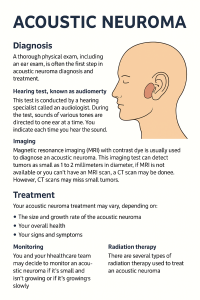Overview
Diagnosis

Acoustic neuroma, also known as vestibular schwannoma, can be difficult to detect early because its symptoms develop gradually and are often subtle. Common symptoms, such as hearing loss, may overlap with other ear conditions.
Initial Evaluation:
-
A thorough physical examination, including an ear exam, is usually the first step.
-
Your healthcare provider will ask about your symptoms, such as changes in hearing, balance issues, or tinnitus (ringing in the ear).
Diagnostic Tests:
-
Hearing Test (Audiometry): Conducted by an audiologist, this test evaluates hearing in each ear using tones and words at various volumes to determine the softest sounds you can hear.
-
Imaging:
-
MRI with contrast is the preferred method, capable of detecting tumors as small as 1–2 millimeters.
-
CT scan may be used if MRI is unavailable or contraindicated, but small tumors may be missed.
-
Treatment
Treatment depends on several factors, including the size and growth rate of the tumor, your overall health, and your symptoms. The main approaches are monitoring, surgery, and radiation therapy.
1. Monitoring
-
Recommended for small, slow-growing tumors or for older adults or patients who cannot undergo aggressive treatment.
-
Involves regular imaging and hearing tests, typically every 6–12 months, to track tumor growth.
-
If the tumor grows or symptoms worsen, surgery or radiation may become necessary.
2. Surgery
Surgery is considered when the tumor is large, growing, or causing symptoms.
-
Goal: Remove the tumor while preserving the facial nerve to prevent facial paralysis. Complete removal may not always be possible if the tumor is near critical structures.
-
Procedure: Performed under general anesthesia, surgeons access the tumor through the inner ear or a skull window.
-
Postoperative Effects: Temporary balance issues are common; hearing may be lost on the affected side.
-
Potential Complications:
-
Cerebrospinal fluid leakage
-
Hearing loss
-
Facial weakness or numbness
-
Tinnitus
-
Balance problems
-
Persistent headache
-
Rarely, meningitis, stroke, or brain bleeding
-
3. Radiation Therapy
Used to stop tumor growth or as an alternative to surgery for patients who cannot undergo surgery.
-
Stereotactic Radiosurgery (e.g., Gamma Knife, CyberKnife): Delivers a precise dose of gamma rays to small tumors (<2.5 cm) without incisions. Effects may take weeks to years.
-
Fractionated Stereotactic Radiotherapy (SRT): Administers smaller doses over several sessions to slow tumor growth while protecting surrounding brain tissue.
-
Proton Beam Therapy: Uses targeted proton particles to minimize radiation exposure to surrounding tissue.
Risks of radiation therapy:
-
Hearing loss
-
Tinnitus
-
Facial weakness or numbness
-
Balance difficulties
-
Rare continued tumor growth
Supportive Therapy
In addition to treatment aimed at removing or controlling the tumor, supportive therapies help manage symptoms:
-
Balance therapy, physical therapy, and occupational therapy for dizziness or balance problems
-
Hearing aids or cochlear implants for hearing loss
-
Ongoing monitoring to track recovery and prevent complications
Comprehensive care at specialized centers, like Mayo Clinic, emphasizes both tumor management and symptom support to optimize patient outcomes.
Advertisement
